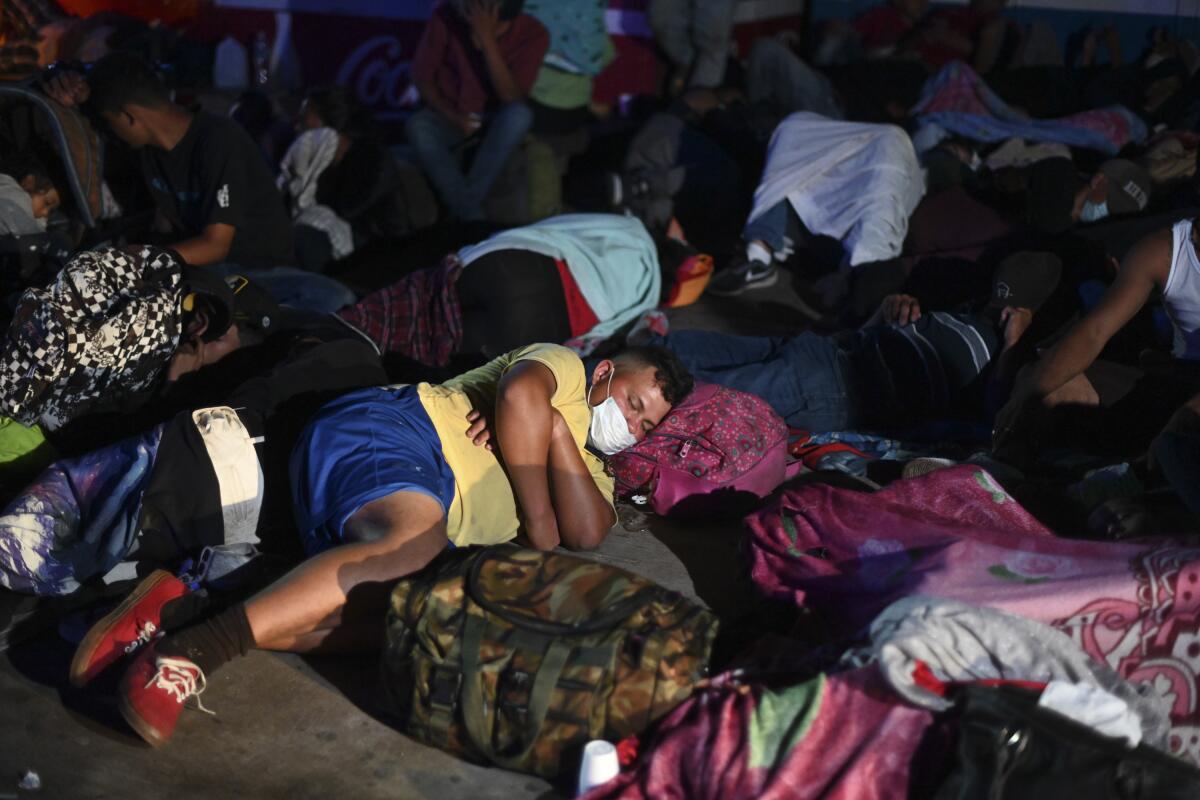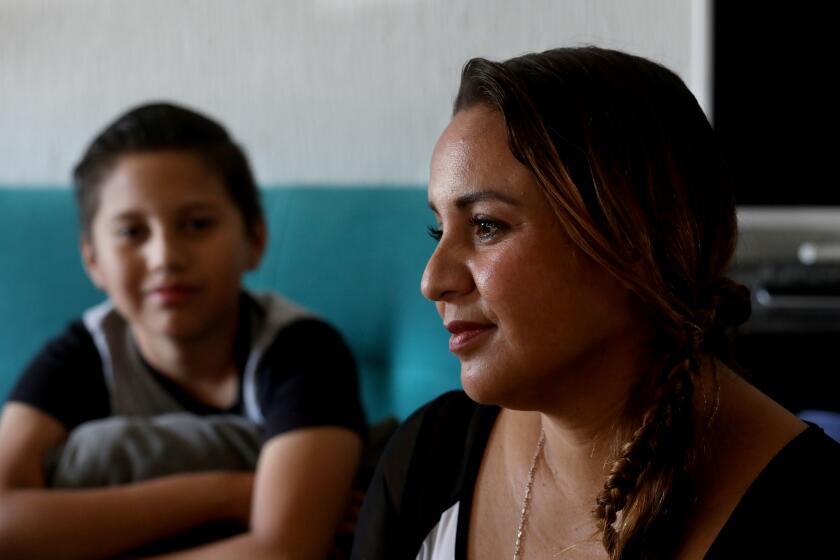As another migrant caravan heads toward the United States, skeptics ask: Why now?

- Share via
MEXICO CITY — As a new caravan of about 2,000 Honduran migrants pushed north through Central America toward the United States this week, people throughout the region were asking a question: Why now?
Some political analysts and government leaders are suspicious of the caravan’s timing — a month before the U.S. presidential vote — given that a similar mass migration weeks before the 2018 midterm elections became a major campaign issue used by President Trump and other Republicans to drive immigration-wary supporters to the polls.
Mexican President Andrés Manuel López Obrador said Friday that there might be political motives behind the new caravan, though he acknowledged he did not have “all the elements” to support that belief.
The coronavirus is eroding decades of slow but steady progress in building up Mexico’s middle class. Economists say the damage will be long-lasting.
“It’s a matter that I believe is linked to the U.S. election,” López Obrador told journalists at his daily news conference. “It is very weird, very strange that the caravan set out on the eve of the vote.”
Many people are openly toying with opinions about the caravan, including an academic who questioned whether Honduras’ ruling party might have played a role in organizing the caravan and members of the Honduran government who have blamed diverse forces, including liberal nonprofits, criminal groups and the billionaire philanthropist George Soros.
There is no public evidence that the latest caravan or any earlier iterations were organized by people or groups trying to influence U.S. elections.
Several migrants said speculation about their timing or motives distracts from the reasons that they are fleeing Honduras: entrenched poverty, endemic violence and overt government corruption — all of which have grown worse during the COVID-19 pandemic.
“This isn’t a political movement, and we don’t care about the elections in any other country,” said a caravan member named Ariel, who is an administrator of the WhatsApp group in which migrants have organized themselves. “We’re dying of hunger and are just looking for a country that can offer us life with dignity.”
On Thursday, members of the latest caravan maneuvered past immigration officials to enter Guatemala before beginning the several-day trek toward the Mexican border.
Ariel, a 26-year-old who asked to be identified only by his first name because he fears retribution from authorities back home, said he decided to join the caravan because he was kidnapped for ransom five months ago by police officers.
He said he learned about the caravan forming on social media. As for its timing of the caravan, he said migrants left this week because until a few weeks ago, the country’s borders were closed as a coronavirus precaution.
Just days after Honduras confirmed its first cases of COVID-19 on March 10, President Juan Orlando Hernández ordered a near-complete lockdown of the country, closing its borders and issuing a curfew that required people to stay in their homes except for a few hours each week.
Those swift actions may have spared Honduras from a mass outbreak — the nation has seen just over 2,380 coronavirus deaths, according to data compiled by Johns Hopkins University. But human rights advocates say officials in Honduras have used the curfew to justify a military crackdown, and more than 63,000 people have been arrested for breaking curfew in recent months, including journalists and activists.
Many businesses have closed, hunger is widespread, and evictions have spiked, forcing families into the streets.
Hernández, who several years ago admitted that his campaign had been funded in part by millions of dollars stolen from the country’s Social Security Institute, and who was recently named by U.S. prosecutors as a co-conspirator in a drug trafficking case against his younger brother, has been linked to another corruption scandal. A recent government audit of the Honduran agency tasked with procuring medical supplies to fight the coronavirus found tens of millions of dollars wasted.
“Where’s the money?” read large banners that have sprung up across the country in recent months.
Migrants have been leaving the country in large groups since at least 2017, inspired in part by annual “Stations of the Cross” processions in Mexico, where activists marched during Lent to bring attention to that country’s harsh immigration enforcement. They say that there is safety in numbers and that traveling together means they don’t have to pay smugglers for protection.
The caravans didn’t capture widespread U.S. attention until 2018, when Trump began frequently tweeting about them, saying they proved the U.S. needed to build a border wall. When a group of 7,000 mostly Central American migrants headed north shortly before the midterm elections, Trump seized on the issue and sent soldiers to the border.
Many of the migrants in that caravan ended up stranded in Tijuana and other border cities after the Trump administration issued a rule requiring asylum seekers to wait in Mexico for their immigration court cases in the U.S. Some headed back to Honduras, while others built lives in Mexico.
It is unclear whether the current caravan will make it into Mexico. Guatemala President Alejandro Giammattei said in a video address Thursday that migrants who are apprehended will be deported.
“The order has been given to detain all those who entered illegally, and return them to the border of their country,” Giammattei said. “We will not allow any foreigner who has used illegal methods to enter the country to think that they have the right to come and infect us and put us at serious risk.”
While López Obrador said Mexicans “do not want confrontation,” his immigration agency released a statement Thursday saying the migrants represent a health risk and warned that any foreigner who threatened public health could be imprisoned.
López Obrador, who had advocated a more humane approach to migrants, adopted much harsher tactics after Trump threatened to impose tariffs on Mexican imports if Mexico didn’t stop the migrants. In January, when a different caravan approached the Guatemala-Mexican border, National Guard troops in riot gear blocked their way and fired tear gas canisters, and hundreds of people were put on planes and buses back to Honduras.
Itsmania Platero, a migrant activist in Honduras, said the January caravan was proof that the caravans are not connected to U.S. politics, although she acknowledged that there are interest groups that try to take advantage of them.
“People on all sides use them,” she said of the migrants. “These poor people have become cannon fodder.”
Times staff writer Linthicum reported from Mexico City and special correspondent Cerrato from Tegucigalpa, Honduras.
More to Read
Sign up for Essential California
The most important California stories and recommendations in your inbox every morning.
You may occasionally receive promotional content from the Los Angeles Times.















